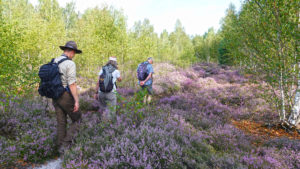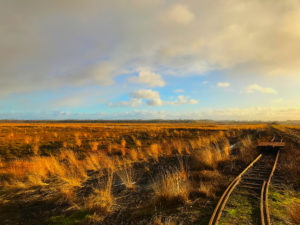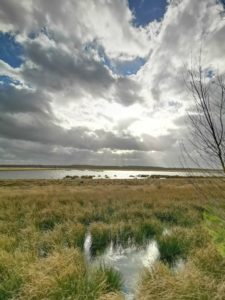Dalum-Wietmarscher-Moor, Lower Saxony, Germany © Naturpark Moor-Veenland, Holger Leue
Written by Hauke Zirfas
Close cooperation between Germany and the Netherlands
The Internationaler Naturpark Bourtanger Moor – Veenland connects the northern border between Germany and the Netherlands. Since 2006 the nature park has been supporting sustainable development in the region and makes a decisive contribution to the cross-border protection of species and biotopes. In close cooperation between the German districts of Emsland and Grafschaft Bentheim and the Dutch province of Drenthe, the European spirit becomes tangible in the midst of nature.

Transboundary Park qualification ©BvdH
A gigantic raised bog once stretched from northwest Germany all the way into the Netherlands: the Bourtanger Moor. It was the largest contiguous moor area in Central Europe. This archaic habitat was considered sacred by the pagan tribes of this region. Since the moor grew over thousands of years, it finally reached a height of over 8 meters and was able to influence the weather in its favor thanks to its huge water reservoir. Moist air masses were caused to rain down by the evaporation cold of the bog, which allowed it to grow even more. Only people familiar with the area knew the secret paths through the moor. But life on the edge of this barren landscape was marked by hardship. For a long time the moor was an unspecified border between Germany and the Netherlands.
History of the bog area
Until the second half of the 20th century, this area was marked by poverty and “backwardness”, especially on the German side. Individual peat workers’ settlements huddled in the barren landscape. In the Netherlands, where the drainage of the moorland began much earlier, people used to say: “Germany begins where civilization ends.”
In the middle of the 20th century, this was to be changed with a large-scale development plan. With the largest plow in the world, the “Mammut”, the moor in the Emsland was torn up, turned over and ultimately converted into arable and building land. Most of the few remaining bog areas were destroyed by peat digging. A peat power plant was even put into operation, which produced electricity with a very high amount of energy.

Internationaler Naturpark Bourtanger Moor – Veenland ©Hauke Zirfas
At that time, the consequences of the extensive destruction of the raised bog areas were not foreseeable. Nobody ever heard of an impending climate catastrophe. Nobody could have foreseen the droughts that are now threatening large parts of Europe. However, due to their stored carbon, raised bogs represent a fundamental adjustment screw in climate protection. With a global area ten times smaller than the world’s forests, peatlands store just as much CO2. However, unlike forests, they hardly have a lobby. For a long period, humans have associated something negative with these valuable ecosystems.
Protection of the unique habitat
Over time, however, there was a rethink. The bog, which was viewed as hostile and “useless”, was given a new status.
To protect this unique habitat, the cross-border Internationaler Naturpark Bourtanger Moor – Veenland was founded in 2006.

Internationaler Naturpark Bourtanger Moor – Veenland ©BvdH
On a core area of 140 square kilometers, work is carried out in close cross-border cooperation to protect and develop the fascinating ecosystems of this region. In addition to the raised bogs to be renatured, this also applies to idyllic river landscapes, picturesque heathland and ancient pastoral forests.
White-tailed eagles, beavers and occasionally individual wolves roam the area of the nature park again today. In addition to species and biotope protection, the focus is also on sustainable development of the cross-border region. Networking is achieved through environmental education, funding projects and a nature-friendly touristic offering, which also ensures the preservation of their homeland for future generations. Just as the mosses of the moor interweave, so it is with the people.